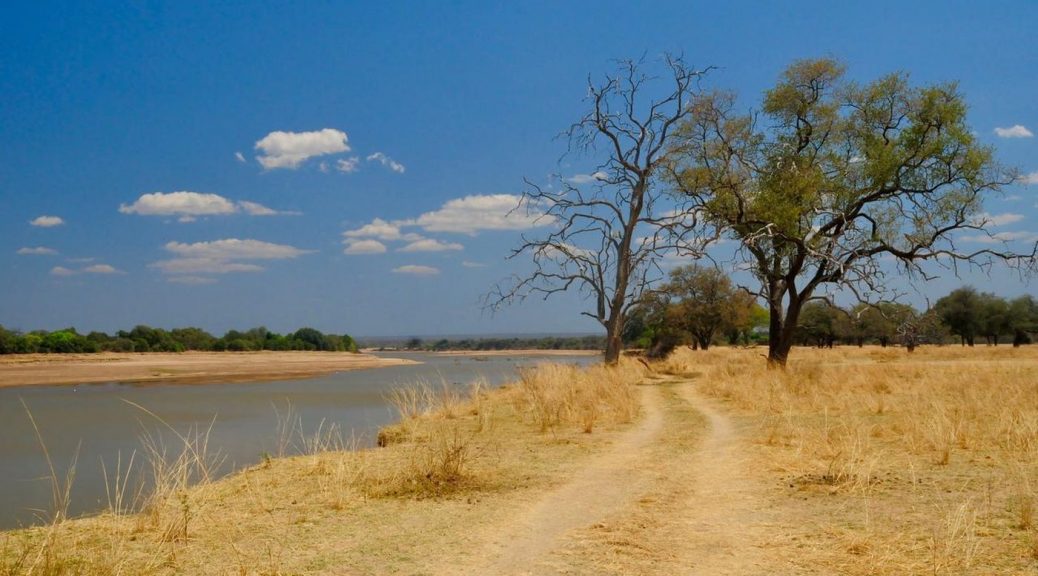Considering a self-drive trip to Zambia? Don’t miss out on these five destinations that showcase the country at its finest. Best of all, our Zambia Paper Map makes exploring a cinch. By Nell Hofmeyr
As much as we love the trio of countries known as ‘Africa-lite’ (Botswana, South Africa and Namibia), Zambia offers an altogether different kind of adventure. Picture unspoiled nature, minimal tourists and meandering roads that stretch on forever. We rounded up five of our favourite travel spots to see you on your way.
And remember: The terrain can be a struggle, but navigation doesn’t have to be – not with our Zambia Paper Map as your guide.
Liuwa Plain National Park
Situated in Zambia’s remote west, this vast stretch of untouched grassland made the New York Times “Top 52 Places to Visit” in 2018 – and we can’t say we’re surprised. Come November, the park plays host to the second largest wildebeest migration in Africa. It’s a sight every bit as spectacular as the Great Migration up north but, thankfully, with far fewer crowds.
Liuwa is open to travellers for most of the year but is best visited between June and December when the seasonal floods are over, and wildlife is abundant. Take note that accessing the park during the dry season requires 4×4 driving and some comfort with sand tracks.

T4A stat: Liuwa Plains is listed as one of Zambia’s 42 Important Bird Areas.
“During our first game drive we ticked an impressive list of large waterbirds. According to the park’s website, 334 bird species call the area home and, as a casual birder, I was impressed by the storks, cranes and pelicans.” – Johann Groenewald
Also read: Liuwa Plain: a national park that delights
South Luangwa National Park
Indisputably the country’s premier park for wildlife sightings, South Luangwa guarantees to impress every time. Here you can spot four of the Big Five (sadly, there are no rhino left in the park due to poaching), large herds of elephant and buffalo, lagoon-dwelling hippos and endemic subspecies such as Crawshay’s zebra and Thornicroft’s giraffe.
The park is world-famous for its guided walking safaris which allow visitors to touch, feel and smell the bush in a way that’s only possible on foot. The wide range of luxury lodges, tented camps and affordable campsites ensures there’s accommodation to suit every budget.

T4A stat: South Luangwa National Park hosts the world’s highest naturally occurring concentration of leopards.
“The ambiance and spectacular number of animals in South Luangwa is extraordinary.” – Johann Groenewald
Also read: 10 reasons to visit Zambia
Victoria Falls
No list of Zambia recommendations worth its salt would dare leave off the mighty Victoria Falls – that iconic curtain of falling water found at the border with Zimbabwe. Up close, it’s a sight even more astonishing than the postcards promise, and you’re left in no doubt as to where its other name ‘Mosi-oa-Tunya’ (‘The Smoke that Thunders’) stems from, or why it’s considered worthy of UNESCO World Heritage status.
An unforgettable way to admire the falls is with a dip in Devil’s Pool, a rocky swimming hole positioned right at the cliff’s edge with views of the gorge below. To do so, time your visit between August and January when the pool is open to tourists.

T4A stat: More than five hundred million cubic metres of water per minute travel over the cliff edge.
“Whilst the Victoria Falls are Zambia’s best known attraction, few people know that the Kalambo Falls at 221m is the second highest uninterrupted waterfall in Africa. There also are a number of little-known but beautiful waterfalls that are worth visiting during or shortly after the rainy season (November to April).” – Johann Groenewald
Buy now: Guide to little known waterfalls of Zambia Volume II
Kafue National Park
Zambia’s oldest and largest national park is renowned for its diverse landscapes and off-the-beaten-path feel. Covering a massive 22,400 km2 , there is no shortage of sights and activities to enjoy. Head to Busanga Plains in the far north for exceptional encounters with lions and pristine wetland wilderness. The Plains Camp, set on a small palm tree island in the middle of the plains, is a fantastic base for embarking on an authentic safari experience.
T4A stat: The park accounts for approximately 33% of the country’s national park system.

“The park is almost the size of Wales; therefore, you may drive a whole day and only see one or two other vehicles.” – Johann Groenewald
Also read: Kafue National Park offers a true wild Africa experience
Chimfunshi Wildlife Orphanage
Home to 120 rescued chimpanzees, this sanctuary along the banks of the Kafue River is one of Zambia’s great conservation success stories. It was founded in 1983 after a game ranger brought a badly wounded chimp in need of care to the cattle ranch of David and Sheila Siddle.
In the 27 years since, Chimfunshi has evolved into one of the biggest sanctuaries of its kind globally and established itself as a major centre for education and research. Pay a visit to this inspiring organisation to observe the complex social behaviour of these extraordinary creatures.

T4A stat: The original chimpanzee arrived at the Siddle farm in 1983 and was named Pal.
“In the Copperbelt, there is not much in the way of tourism, but Chimfunshi is a reason to make a detour. The chimpanzees are fed in the mornings when you can observe them from the roof of their feeding area. You can camp at Chimfunshi or stay in basic but very adequate self-catering chalets.” – Johann Groenewald
Also read: Chimfunshi: a sanctuary for chimps in need
Discover the best of Zambia using our newly launched Zambia Traveller’s Paper Map. Read this blog for more information on what you can expect.

